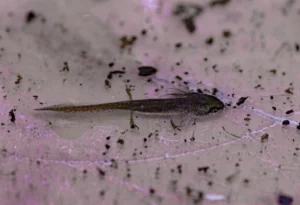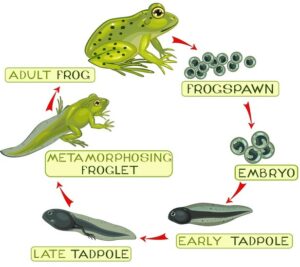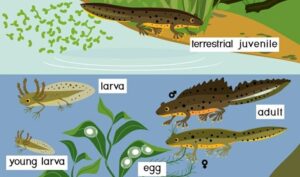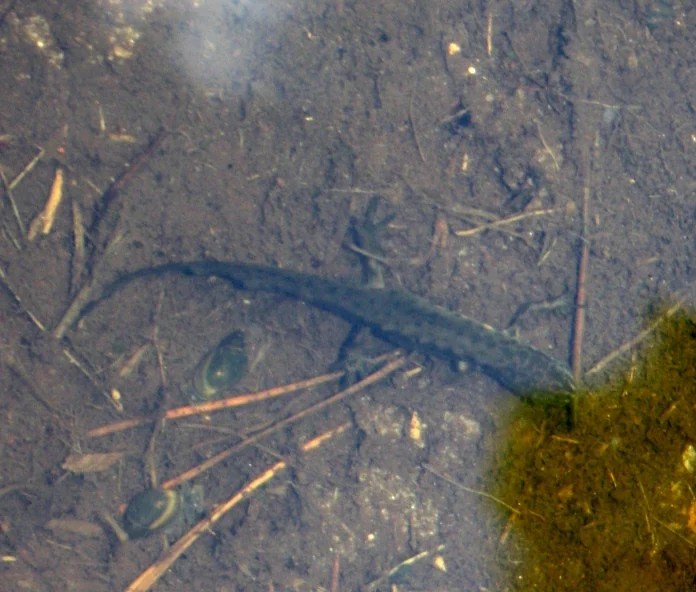If you’ve ever spotted a tiny creature in a pond, you might have wondered, was that a baby frog, or maybe a newt? At first glance, they look alike. But do newts actually turn into frogs, or are they something different?
Newts don’t turn into frogs. They are a type of salamander, which is a different group of amphibians. Frogs and newts share some similarities, but their life cycles, bodies, and how they survive are not the same.
Still, it’s easy to see why people get confused; especially when you notice how similar they look when they’re babies.
Why People Often Mix Up Newts and Frogs
If you’ve ever scooped pond water into a jar as a kid, you probably saw tiny wiggling larvae that all looked the same.
Small tails, no legs yet, and gills sticking out from the sides.

At this stage, frog tadpoles and baby newts are easy to mix up. Both live in the water for weeks, both breathe through gills, and both eat tiny bits of small food floating around.

Without looking closely, it’s hard to tell them apart.
But as they grow, the differences start to show.
Do Newts and Frogs Belong to the Same Family?
Here’s where it gets interesting.
Frogs belong to a group called anurans, while newts are salamanders, specifically in the group called Caudata.
In simple terms, frogs and newts are like distant cousins. They share the same “amphibian” background, but their family branches split millions of years ago.
So a frog never becomes a newt, and a newt never becomes a frog, but they both inherited some traits from a very old ancestor.
What Happens in a Frog’s Life Cycle
Frogs follow a clear pattern:
-
Eggs in water – Jelly-like clusters that stick together.
-
Tadpoles with gills – Swim and eat algae.
-
Tadpoles with legs – Arms and legs slowly grow.
-
Young froglets – Tail shrinks, lungs replace gills.
-
Adult frog – Jumps, croaks, and lives mostly on land but stays near water.

This full change from egg to land-living adult is called metamorphosis, a big word that just means the animal changes form as it grows.
What Happens in a Newt’s Life Cycle
Now let’s compare with newts:
-
Eggs in water – Laid individually on plants, each carefully wrapped in a leaf by the female.
-
Larvae with gills – Like tadpoles, but slimmer with little feathery gills on the outside.
-
Efts (juvenile newts) – Leave the water, live on land for a while, with rough skin and bright colors.
-
Adults – Go back to the water each spring for breeding, but spend the rest of the year on land.

Unlike frogs, newts keep their tails for life. That tail is very useful for swimming.
Why Don’t Newts Turn Into Frogs?
The reason is simple: they evolved for different lifestyles. Frogs are built for jumping, calling loudly, and leaping away from danger.
Newts are built for swimming with tails, walking quietly on land, and hiding instead of hopping.
If a newt suddenly turned into a frog, it would lose the tail and body shape that help it survive. Evolution doesn’t work that way, each animal followed its own path.
Do Any Amphibians Change Form Like That?
You might wonder if any animals switch forms in extreme ways. Some salamanders can keep their gills and stay in water their whole lives, like axolotls. Others skip the land stage completely.
But no amphibian turns into another type altogether. A frog will always be a frog. A newt will always be a newt.
What About the Red Eft, Is It a Frog?
If you’ve ever seen a tiny bright orange creature crawling in the woods, that’s a red eft. These are juvenile eastern newts. Their bright color warns predators that they taste bad.

Some people think they’re baby frogs because they live on land and don’t look like slim, slippery newts in ponds.
But they’re still newts, just in a different stage. Eventually, they go back to the water as adults.
Why Do Frogs and Newts Look Similar at First?
This is really interesting. Their early stages look alike because baby frogs and newts face the same problems:
-
They both need gills to breathe in water.
-
They both need tails to swim.
-
They both start small and vulnerable, so hiding and growing fast are key.
Nature gave them similar tools for the same challenges, even though their adult forms are very different.
How Scientists Tell Frog Tadpoles From Newt Larvae
If you want to spot the difference:
-
Frog tadpoles have rounder bodies, no frilly external gills, and usually eat plants.
-
Newt larvae have slimmer bodies, feathery gills on the outside, and start eating tiny insect larvae sooner.
Once you know what to look for, it’s easier to see who’s who in a pond.
Do Frogs and Newts Share the Same Pond?
Yes, and it can be confusing. A single pond in spring may have both frog eggs and newt eggs. Later, tadpoles and newt larvae swim side by side.
They usually don’t compete much. Frog tadpoles mostly eat algae and plants, while newt larvae go for small insects.
Eating different foods keeps them from getting in each other’s way.
What If Frogs and Newts Could Swap Lives?
It’s fun to imagine. A frog trying to live like a newt, or a newt like a frog?
-
A frog without a strong tail wouldn’t swim as well as a newt.
-
A newt without a frog’s strong legs couldn’t leap to escape danger.
Both would struggle outside their natural roles. It shows how well each animal is made for its own way of life.
Conclusion
So, do newts turn into frogs? No, they are different amphibians with different life paths.
Frogs lose their tails and become jumpers, while newts keep their tails, grow into land-living efts, and then go back to the water as adults.
They may look alike as babies, but their adult lives are very different. The confusion is natural, but once you know the signs, it’s easy to see that newts stay newts, and frogs stay frogs.
Hi, my name is Ezra Mushala, i have been interested animals all my life. I am the main author and editor here at snakeinformer.com.

